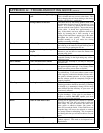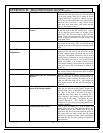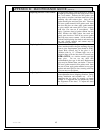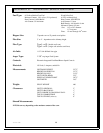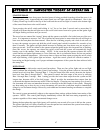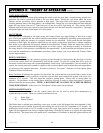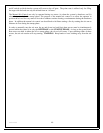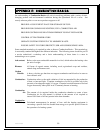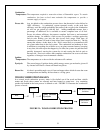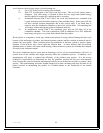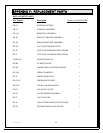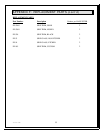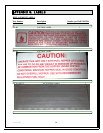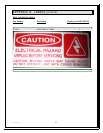
Version 2.0b 52
The obvious advantage of wood pellets over conventional chopped wood logs is the consistency of the
fuel both from a size and moisture content. Thus, wood pellets burn more efficiently than their log
counterparts. The heat generated in the burn process, once combustion is achieved, sustains the process
as more fuel is added. As the gases burn, the pellet stove’s firebox temperature can reach up to 2000
o
Fahrenheit. The obvious advantage of corn fuel is it is Nature’s palletized fuel. As customer demand
for wood pellets increase, corn fuel will be readily available across America. The list below gives a
sample of ignition temperatures for some of the carbon and volatile matters released when wood is burnt:
COMBUSTIBLE FORMULA IGNITION TEMP (
O
F)
Fixed Carbon C 765 – 1115
Volatiles
Hydrogen H
2
1076 – 1094
Methane CH
4
1202 – 1382
Ethylene C
2
H
4
1008 – 1018
Benzene C
6
H
6
1364
Ethane C
2
H
6
968 – 1166
Carbon Monoxide CO 1191 – 1216
Note that all ignition temperatures fall between 950
o
F through 1400
o
F for volatile matter. All visible
flames emitted during a wood fire come from the ignition of volatile matter. Good combustion occurs
when the fuel vapors are thoroughly mixed with the combustion air. Mixing ensures that fuel molecules
come in contact with oxygen fuel molecules. There must be an abundant amount of oxygen molecules
available to react with the fuel molecules or an incomplete burn will occur. NOTE: The fuel-air mixture
must at all times exceed the combustion temperature as well as exceed the ignition temperature if a burn
is to be sustained. There must be adequate time for the reaction to proceed to completion (complete
burn.) It is commonly stated that good conditions for combustion are defined as the THREE T’s:
Turbulence Temperature Time
It requires turbulence in the fuel-air path to ensure that fuel and air molecules are thoroughly mixed to
sustain the burn process. In addition, it takes a certain amount of temperature, defined as Ignition
Temperature to sustain the burn if volatile and carbon matter and it takes a certain combustion
temperature to ensure volatile and carbon matter is released from the fuel that will then combine with the
oxygen in the air. All of this takes time to occur and is self-sustaining only if all conditions are met for
the fuel being burnt.
Heat is obtained from a stove by the thermal radiation that occurs from the burning wood pellets.
Although a fairly complex phenomena to define, the heat radiated from the fire is a very strong function
of the local (burn pot) temperature and the overall combustion temperature that is maintained within a
stove’s burn chamber. A relatively minor combustion temperature increase in a pellet stove can produce
a significant amount of increased heat output. NOTE: The reverse of the preceding statement is also true.
That is, if too much heat is pulled from the combustion chamber via the heat exchanger tubes, the
combustion temperature can drop rapidly thus causing a “burn out” once the combustion chamber drops
below the critical “ignition temperatures” required of the different fuel components. Wood pellets,
because of their low combustion temperature ensure an ample supply of volatile and carbon matters
available for continued ignition. However, for other types of fuel, such as corn, it is important that the
service technician understand the complexity of this principle and how environmental variables can affect
the combustion chamber, combustion temperature, and ignition temperatures. Once a burn chamber’s
temperature begins to fall below critical ignition temperatures, the heat required to sustain the combustion
temperature can also be lost and the fire will go out.



